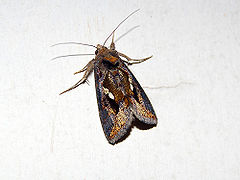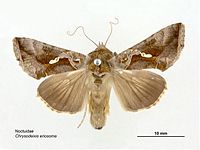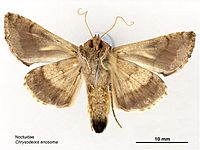- Chrysodeixis eriosoma
-
Chrysodeixis eriosoma 
Scientific classification Kingdom: Animalia Phylum: Arthropoda Class: Insecta Order: Lepidoptera Family: Noctuidae Genus: Chrysodeixis Species: C. eriosoma Binomial name Chrysodeixis eriosoma
(Doubleday, 1843)Synonyms Plusia eriosoma Doubleday, 1843
The Green Garden Looper (Chrysodeixis eriosoma) is a moth of the family Noctuidae.
Contents
Description
Adult
Wingspan 42 mm [1]
Differs from Chrysodeixis signata in the head, thorax, and fore wing having a reddish tinge ; abdomen with the lateral and anal tufts often black in the male. Fore wing with much more gilding on the basal, medial, and outer areas ; the antemedial line more oblique, the postmedial more oblique and sinuous ; the Y mark large, prominent, and golden, the arms often filled in with golden and occasionally joined to the tail.[1]
The adult moth is dark grey-brown, with bunched hairs on its head which look like a short pair of horns. Males have long orange hair-like scales on either side of the abdomen, which are distinctive for this species, and these are probably the origin of the scientific name, as in Greek, erith - red, and soma - body. On each fore wing of males and females is a silvery figure of eight with the two halves separated, unlike the related species Chrysodeixis subsidens in which they are fused together. The absence of a tiny silver 's' on the fore wings distinguishes it from another related species: Chrysodeixis argentifera. They all have a wingspan of about 3 cms. The chemical identities of the sex attractants (Pheromones) for this moth have been elucidated. [2]
Some specimens are much darker than others.[1]
Larva
The larvae are green with a number of faint white lines along the animal's length. They also sometimes have black dots along the sides. Some of their ventral prolegs are missing and this makes them move looper fashion, like the Caterpillars of Geometridae. They grow to a length of about 4 cms. [2]
Larva green, the back palest, with indistinct dorsal and lateral pale lines. Food-plant, Ficus.[1]
Life cycle
Pupal duration varies from about a fortnight in summer to about a month in winter. [2]
Distribution
North and South America; Wadelai; Aden;Japan; China; throughout the Indian, Malayan, and Australasian regions.[1]
References
- ^ a b c d e G. F. Hampson (1895) The Fauna of British India including Ceylon and Burma, Moths Vol. II
- ^ a b c Coffs Harbour Butterfly House, Maze and Tearooms

This Plusiinae-related article is a stub. You can help Wikipedia by expanding it.


